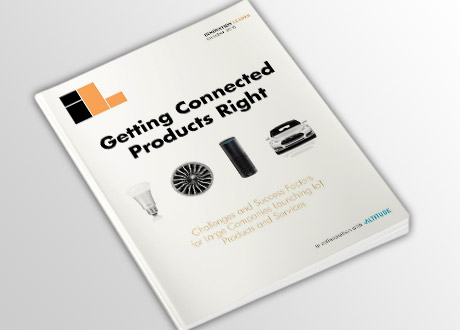How National Culture and Policy Impact Innovation Strategies
National cultures and policies influence innovation rates, approaches to innovation, and funding. Here's what innovation leaders need to know.
Four Ways to Innovate Right Now
While the pandemic has been difficult for all us economically, as business owners, we never run out of opportunities. No matter the business climate, there is always a chance to do something new and something better—you just have to find it.
Five Aspects of Innovation Governance
The leverage point is to let innovation shine via effective governance discipline, but not adding too much complexity. In this article, we'll look at what innovation governance is, and practices to help you manage a successful innovation program.
The Card Game to Help You Innovate Like Tesla
Visions and consequently major innovations are molded by the technical and human revolutions that industries live in. In a time when just one big industrial revolution existed, every company simply had to follow the common path (see production automation in the 60's-70's). The 20th century car industry was a good example. Then Internet technology came onto the scene (more complex and diverse than the web from the early 2000's) and the thread for innovation is no longer so straight forward.
Disruption Planning 2- Creating Options and Pathways
In this in-depth article Haydn Shaughnessy discusses why traditional ROI decision making is becoming irrelevant and how options planning is a key element of competitiveness. In these uncertain times firms need to recognise and analyse their options thoroughly in order to be ready for inevitable change.
Leap Innovation: a Strategy to Get Ahead and Stay Relevant
The importance of innovation for organizations to remain competitive is widely discussed and well accepted by scholars and practicing managers. However, failures in innovation attempts are quite common and raise many questions. Why do firms with innovative products fail? Does market acceptance of innovations alone guarantee continuous success? Is it innovation strategy that can ensure long-term prosperity? One can argue that it is not only how to innovate that matters, but also where, what and when to innovate that make the difference.
7 Steps to Platform Transformation – Part I
Too many notes, Mozart was once told. Too many ideas, we might say today. The culture of innovation is awash with idea generation and its sidekick, fail-fast fail cheap innovation. Worse, we need a culture of transformation not just innovation. Accenture recently reported that 81% of executives they interviewed see platforms as central to their strategy over the next three years.
Managing Risk and Shortcuts for Project Managers
Project managers are often dealing with loads of stress coming from all fronts, such as the pursuit of deadlines. Pressed by senior managers to deliver, project managers may find themselves resorting to risky shortcuts to make ends meet. Here are some ways to manage these risky shortcuts in project management.
The Value of Disruptive Innovation vs. the Value of Incremental Innovation
Most startups hope to disrupt their markets by delivering a novel idea or a more-suitable functionality—frequently at a lower price. Disruptive Innovation may be how your company arrives, but ultimately, as competition grows and your business and brand evolves, you will need incremental innovation to stay relevant.
High Stakes Industrial Innovation with Paul Brody
Paul Brody is a Global Innovation Leader in BlockChain Technology and a Solution Leader in the Industrial Internet of Things at EY. Paul has spent more than 15 years in the electronics industry and has done extensive research for his clients on technology strategy. Paul understands that technology is deeply rooted in strategy, but it gets complex as new technologies and disruptions arise in our modern world. For example, the moment self-driving cars are perfected, it will cause a huge disruption in our economy, so how can we navigate through it?
Innovation Fitness: Measuring It to Maximize It
To gauge the innovation capabilities of an enterprise, it is helpful to apply a systematic method for assessing the quality of, and the relationship between the various and distinct dimensions that drive all functions of the enterprise. As with a sports team, simply having talent does not ensure success. It is the quality of the team work which ultimately elevates or hinders the level of their play.
How is Crowdsourcing Uniquely Beneficial to Technologists
Innovation proves vital for companies across industries, but carries key importance in the technology field. Mainstream perception of the tech industry conjures illustrations of cutting edge, never-before-seen products poised to disrupt and revolutionize daily lives.
How to Increase your ‘Return on Innovation’?
While the importance of innovation is crystal clear for many organizations, daily execution usually remains challenging. When renewing products, services or business processes, companies often encounter the same obstacles. But what if companies could learn from each other? Can innovation be streamlined by sharing successes and failures? That’s precisely what the first CREAX innovation roundtable was determined to find out. In collaboration with Oracle, we gathered a diverse group of innovation professionals for a lively debate on how to move from theorizing to getting things done. This is what we learned.
Building an Innovative Nonprofit: the Value of Crowdsourcing
Crowdsourcing is often associated with start-ups and blue-chip companies who are trying to innovate, but it has the potential to reach far beyond those with seed money and infinite endowments. The beauty of crowdsourcing is that it is rooted in grassroots fundamentals—an environment that is ideal for non-profit businesses.
Getting Connected Products Right
Why do so many companies seem to be sitting on the sidelines when it comes to creating connected products and designing services that tie into them? The cost of adding wireless connectivity to a device is plummeting toward $1. Projections about how many Internet of Things (IoT) objects will be part of our lives, at work or at home, range from 12 billion by 2020 (Cisco) to 50 billion (Ericsson and Intel).
Metrics and Measurements for Open Innovation and Ecosystems
Given the difficulties in developing and working with metrics and measures for open innovation and ecosystems, I have pulled together some inspiration and insights from several articles.
Product Innovation of a Trolley: A 3-step Journey
Consider the world’s most ingeniously designed products. Whether it’s your smartphone, your favorite racing bike or a nifty robotic lawn mower – they all have a one thing in common: rather than being conceived overnight, they were shaped by a series of consecutive, systematic innovations. But how does such a structured product innovation approach look? This CREAX project illustrates the ins and outs.
The Changing Face of Corporate Intrapreneurship
In early September 85 smart people gathered for two days at the Pfizer conference center in New York City to talk about their practical experience in identifying, engaging, driving value from and (at times) failing with the most innovative employees in their respective businesses. The 2016 Corporate Intrapreneur Summit was 100% on point in targeting key areas of interest around how intrapreneurs in a corporate setting.
A Roadmap for Building Corporate Innovation Capabilities
What should a roadmap that helps you develop corporate innovation capabilities look like? How do you bring new thoughts and approaches together with current and past initiatives (both successes and failures) and turn this into a single framework? How do you keep pushing and developing your organization to become more flexible and agile without losing out on the current overall efforts and expected results?
What are the Key Innovation Challenges?
Innovation has become a business mantra and a word that threatens to lose all meaning every time it’s uttered at another conference or thrown into another book title. But in spite of its omnipresence it continues to be essential – a growing field – and one of the only practices that might save businesses from extinction.
Launch a Four-Week Innovation Program
In-house innovation programs are an emerging phenomenon. Many businesses and government organizations are formalizing processes around the innovation practice in order to keep pace with competition and the rapidly changing expectations of the public.
How to Innovate Efficiently: Six Ways to ‘Unfuzzy’ the Front-end
Kittens are ‘fuzzy’ because they’re soft and fluffy. But if someone uses the same word to describe the early stages – or ‘front-end’ – of an innovation process, the meaning is less cute. In that case, ‘fuzzy’ means ‘blurry’, ‘unclear’ or even ‘incoherent’. In many cases, innovation projects start off as chaotic and seemingly aimless ventures. In fact, this happens so often, that organizations tend to accept the ‘fuzzy front-end of innovation’ as a necessary evil. At CREAX, we believe front-end fuzziness can and should be drastically reduced in order to innovate efficiently.
Creating an Innovation Network with Rob Wolcott
As Co-Founder & Executive Director of the Kellogg Innovation Network (KIN) and a Clinical Professor of Entrepreneurship & Innovation, Rob Wolcott knows a bit about networking and the politics of innovation. In this episode of Innovation Ecosystem Rob shares practical advice for intrapreneurs who are looking to get stuff done from within the middle of the organization. And for growth leaders of businesses, he also has some great tips about where to get your inspiration!
Integrating Agile with Stage-Gate® – How New Agile-Scrum Methods Lead to Faster and Better Innovation
Recent experiences show that Agile project-management methods can be used in the innovation process and has a great potential to reduce development time and increase the success rate of new products. The article briefly outlines how an Agile method, such as Scrum, can be used within a structured innovation process with milestones and decision points, such as Stage-Gate®, and what benefits it provides to both manufacturers and service-providers.
Multi-tasking – The Challenge of Intermediaries in SME Support for Innovation
In view of creating more competitive regions and industry sectors, innovation capabilities of SMEs play a central role. SMEs are strong economic drivers in many countries, and their ability to innovate will determine the health of national and regional economies in the future. A key support for SMEs in their innovation efforts are public innovation support programmes.
Launching an Innovation Program: What You Don’t Know
Although innovation programs are becoming more and more embedded within the enterprise, it is still very common to find organizations that are just starting to experiment with formal, continuous innovation programs. Many IdeaScale clients that come to us are quietly launching pilot programs as proof-of-concept initiatives that will confirm innovation value for senior leadership.
Involving the Crowd in Product Development
Even before the term was coined in Wired Magazine in 2006, crowdsourcing was utilized as a way to accomplish goals. The strategy had been used for several hundred years before it was officially given a name, but since being named, crowdsourcing has grown into a huge field, spawning subdivisions of the strategy and being used for a multitude of purposes. Wikipedia is one of the most recognizable and mainstream instances of crowdsourcing, designed to elicit and compile knowledge from the masses. Crowdsourcing has been used in real time to track public transportation and traffic updates with various apps.
From Bankruptcy to Industry Leading Success – The LEGO Story
LEGO has earned the right to celebrate. Not only are kids playing with more mini LEGO people than there are human beings on the planet (Delingpole J, 2009) but in 2015, they were nominated by Forbes as the most powerful brand in the world. For a company which was on the brink of bankruptcy in 2004, the toy maker has made an amazing turnaround. They restructured, hired a new CEO, and forged more licensing partnerships than ever before. Most importantly, they discovered the secret to some of the world’s most successful, low risk innovation strategies.








